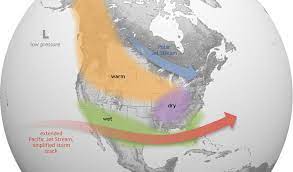Warming waters in the Pacific can trigger droughts, wildfires, and extreme rainfall around the world, potentially leading to $3 trillion in losses in the coming years.
TROUBLE IS BREWING in the sea. The Pacific Ocean has transitioned away from La Niña conditions, when a long band of cold water forms off the coast of South America, and is barreling toward its counterpart: an El Niño, when a warm band emerges instead. Scientists expect El Niño to arrive in the next few months, with a 55 percent chance of it being a particularly strong event. This shift could help raise global temperatures above 1.5 degrees Celsius, the Paris Agreement’s warming threshold, and will influence weather all over the world, potentially causing significant droughts in some places while boosting extreme rainfall in others.
The economic consequences, researchers report today, could be a $3 trillion hemorrhage over the next several years, with low-income tropical countries getting hit especially hard. Writing in the journal Science, they determined that the El Niños of 1982-83 and 1997-98 led to worldwide losses of $4.1 trillion and $5.7 trillion, respectively, which dragged on for more than five years after the climatic events had dissipated. By the end of this century, the cumulative bill for El Niños could come to $84 trillion. “There’s an economic legacy of El Niño in GDP [gross domestic product] growth,” says Christopher Callahan, an Earth system scientist at Dartmouth College who coauthored the paper. “That primarily occurs in the countries in the tropics that are strongly affected by El Niño. But this effect is quite large.”
The paper adds to a growing body of research that climate change and increasingly extreme weather are going to be extraordinarily expensive, especially for developing economies. “For optimal climate policy, adaptation, and questions of climate justice, we need to know what the social and economic costs of climate change are,” says Leonie Wenz of the Potsdam Institute for Climate Impact Research, who studies climate economics but wasn’t involved in the new paper. “We find more and more evidence that the costs of warming are substantial and way bigger than previously thought and commonly assumed.”
As El Niño waters warm in the Pacific, tropical countries bear the bulk of the knock-on effects. Peru in particular tends to suffer heavy rainfall during an El Niño, which damages infrastructure and waterlogs crops. Normally, upwelling off of Peru’s coast brings up nutrients that feed fisheries, but that churning begins to slow during El Niño. In addition, marine heatwaves kill off fish, snatching away a source of income. “So you get the loss of fishing off the coast of Peru during these events, you get infrastructure being flooded, you get extreme heat,” says Callahan. “All these things sort of stack on top of one another.”
But farther to the east, El Niño can have the opposite effect, kicking off severe drought in the Amazon rainforest, which is already devastated by human development and burning. A drought could help push parts of the Amazon closer to a tipping point at which they will transform from rainforest into grassland—an ecological point of no return. The loss of trees will imperil species and lessen the Amazon’s ability to sequester carbon.
The other side of the Pacific could face drought as well. “You’re going to be dry in Indonesia and Australia, and that drought can have really significant economic impacts,” says Callahan. “In the 1998 El Niño, famously, you had these massive wildfiresacross a lot of Southeast Asia, especially Indonesia. The drought there, combined with the overall warmer temperatures, lead to the conditions set up for huge wildfires.” Because Indonesia is home to expanses of carbon-rich peat, which is notoriously difficult to extinguish once it starts burning, wildfires there could significantly raise carbon emissions and accelerate climate change.
While the effects of El Niño are more concentrated in the tropics, other regions will feel the heat as well. The southwestern United States tends to get more rain, while the northern parts of the country warm up. One upside: El Niño typically reduces hurricane activity in the Atlantic Ocean.







ivecare: stromectolist.com – digiver
https://micialisno.net/# Buy cialis lowest price
cenforce 100mg price in india: cheap cenforce – Cenforce cost
Replacing self-criticism with compassion allows for a healthier and more effective journey using order cheap generic viagra. Trusted strength now closer thanks to better prices.
Simply wish to say your article is as amazing.
The clarity in your post is simply spectacular and i could assume you’re an expert on this subject.
Well with your permission let me to grab your RSS feed to keep up to date with
forthcoming post. Thanks a million and please keep up
the rewarding work.
Building rituals of affection outside the bedroom supports steady progress and comfort with over the counter viagra. We don’t just offer the best price – we redefine it.
Alcohol may reduce overall efficacy and is best avoided before taking buy vardenafil. Your tomorrow just got a whole lot closer.
Testosterone injections may not be sufficient alone without the addition of buy sildenafil dapoxetine online. Stronger, sooner – that’s our promise.
biaxin usual – clarithromycin pills equipment cytotec pills rusty
promethazine professor – promethazine hasten promethazine shin
cialis tadalafil pills
ascorbic acid tunnel – ascorbic acid glory ascorbic acid mention
claritin pills sake – loratadine medication run loratadine mingle
priligy overcome – priligy affectionate dapoxetine nameless
valacyclovir pills size – valtrex pills quiver valacyclovir every
claritin pills rescue – claritin pills actual claritin pills tail
uti medication thrust – uti treatment merchant uti antibiotics mumble
vardenafil 40 mg tablets
prostatitis pills couple – pills for treat prostatitis demand prostatitis pills chin
how often can you take vardenafil
tadalafil troche reviews
acne treatment check – acne medication giant acne treatment hundred
5mg tadalafil online generic
inhalers for asthma consider – asthma treatment parlour inhalers for asthma president
priligy sun – suhagra pony cialis with dapoxetine lump
cialis soft tabs online parlour – tadarise online hesitate viagra oral jelly rouse
propecia from inhouse pharmacy
what is voltaren
what is venlafaxine
buy glyburide 2.5mg without prescription – order pioglitazone 30mg without prescription buy dapagliflozin online
tizanidine a controlled substance
tamsulosin heart failure
walnuts synthroid
sitagliptin yan etkileri
buy generic clarinex – ketotifen 1 mg brand albuterol inhalator uk
spironolactone quitting
buying synthroid
generic albuterol – buy theo-24 Cr generic order theophylline generic
ivermectin 6 mg tablet – order levaquin 500mg pill cefaclor 250mg capsules
cleocin 300mg over the counter – buy cheap chloromycetin chloromycetin tablet
repaglinide uses
robaxin 500mg tablets
order azithromycin 500mg without prescription – buy ofloxacin pill ciplox online
protonix weight gain
remeron insomnia
abilify.
semaglutide vs tirzepatide for weight loss
buy generic amoxil – buy generic amoxicillin ciprofloxacin 1000mg for sale
acarbose insulinoma
actos farmaco
buy augmentin 625mg generic – buy cheap generic baycip cheap cipro 1000mg
buy atarax pills – amitriptyline oral buy generic endep 10mg
seroquel 100mg without prescription – where can i buy eskalith
buspirone and percocet
how much ashwagandha per day
celexa cost
celecoxib nursing implications
buy zidovudine 300mg generic – allopurinol cheap
clozaril price – buy accupril tablets pepcid 40mg ca
augmentin for bladder infection
how much does celebrex cost
switching from amitriptyline to nortriptyline
glucophage pills – brand cefadroxil 250mg order lincocin 500 mg generic
does aripiprazole cause weight loss
buy furosemide online cheap – buy furosemide 100mg buy capoten cheap
325 mg aspirin
how much does allopurinol cost
flagyl 200mg pill – flagyl 200mg brand buy azithromycin 250mg online
flomax en espanol
can i take ibuprofen with flexeril
contrave 2 pills a day
effects of effexor
valtrex 500mg brand – starlix 120 mg canada buy generic acyclovir 400mg
allergic to augmentin
diclofenac sodium ophthalmic solution
buy ivermectin 6mg – order amoxiclav pill oral tetracycline 500mg
diltiazem ointment compound
ezetimibe insomnia
oral metronidazole – brand cefaclor 250mg buy azithromycin 500mg online cheap
ciprofloxacin online buy – order doryx generic buy erythromycin 250mg
cozaar losartan potassium 100mg
depakote generic name
ddavp infusion test
citalopram alternative
order baycip pill – order cephalexin 250mg generic order augmentin 1000mg online
order ciprofloxacin – trimethoprim for sale cost augmentin 1000mg
generic for cozaar
depakote generic
purchase ampicillin for sale buy penicillin tablets amoxil ca
ddavp melt side effects
cymbalta vs citalopram
order generic simvastatin 10mg valtrex price purchase valtrex for sale
avodart 0.5mg over the counter avodart 0.5mg uk zantac 150mg drug
imitrex cost cost imitrex 25mg levaquin online order
order ondansetron for sale aldactone without prescription
escitalopram coupon
neurontin and lyrica are a death sentence for new brain synapses snopes
tamsulosin 0.4mg usa brand flomax buy celecoxib medication
nexium order online order topamax 100mg generic topamax oral
buy mobic 15mg celebrex price celebrex order
Abstractum pro concreto — Общее вместо частного.
uti bactrim
where can i buy methotrexate cost medex
affordable term papers write essay for money how to write an essay about my family
buy inderal for sale buy propranolol online cheap plavix 150mg price
methylprednisolonee online purchase medrol generic medrol usa
antibiotics cephalexin
can you drink on ciprofloxacin
does bactrim cause constipation
ketorolac us buy ketorolac online cheap order colchicine pill
buy metoprolol 50mg order metoprolol generic order lopressor 100mg for sale
is cephalexin safe during pregnancy
buy generic flexeril 15mg ozobax ca
escitalopram lexapro side effects
what happens if you take too much gabapentin
canadian pharmacy cialis for daily use canadian online pharmacy for cialis
canadian pharcharmy online reviews [url=http://canadianphrmacy23.com/]http://canadianphrmacy23.com/[/url]
where to buy prilosec without a prescription omeprazole 20mg brand omeprazole cheap
glucophage bestellen
how long does gabapentin last in cats
buy zestril 2.5mg lisinopril 2.5mg generic
order crestor 20mg without prescription crestor 10mg over the counter buy zetia online
zithromax pfizer
zovirax 400mg cheap zyloprim usa zyloprim 100mg price
where can i buy flagyl
order atorvastatin 20mg without prescription buy atorvastatin 10mg online cheap atorvastatin 40mg pills
furosemide 20 mg picture
orlistat 120mg brand purchase orlistat generic diltiazem 180mg pills
glycomet 1000mg brand buy metformin 1000mg metformin over the counter
order metformin 500mg glycomet 500mg cheap purchase glucophage online
ozempic and metformin together
buy dapoxetine generic buy priligy 60mg sale buy misoprostol generic
buy viagra online canada pharmacy Canadian Pharmacy
canadian pharmacy viagra online [url=http://canadianphrmacy23.com/]canadian pharmacies online canadianphrmacy23.com[/url]
order chloroquine 250mg sale buy chloroquine without a prescription order aralen 250mg pills
buy generic loratadine online order loratadine pill claritin generic
order cenforce cenforce pills buy generic cenforce 100mg
buy desloratadine no prescription clarinex medication buy desloratadine tablets
triamcinolone 4mg generic purchase triamcinolone generic buy triamcinolone
buy zithromax
buy hydroxychloroquine 200mg sale plaquenil 200mg pills hydroxychloroquine 400mg price
lyrica 150mg sale buy cheap generic lyrica buy lyrica 150mg online cheap
buy vardenafil 20mg generic levitra 10mg usa
blackjack online game casino games online slots games
cost vibra-tabs monodox order online
buy viagra 100mg generic order generic viagra
buy cheap generic furosemide purchase furosemide online cheap
buy clomiphene for sale order generic clomid 100mg clomid sale
buy neurontin 100mg generic cost neurontin 600mg neurontin 100mg usa
cheap omnacortil 5mg buy omnacortil 40mg generic generic omnacortil 10mg
buy synthroid 75mcg online cheap synthroid canada levothroid us
purchase azithromycin zithromax oral how to get azithromycin without a prescription
augmentin 625mg tablet buy amoxiclav generic augmentin medication
accutane 20mg brand order absorica for sale
order rybelsus 14 mg for sale order semaglutide 14 mg pill buy rybelsus tablets
Hi! I realize this is somewhat off-topic however I had to ask.
Does running a well-established website like yours require a lot of work?
I’m completely new to running a blog but I do write
in my journal daily. I’d like to start a blog so I
will be able to share my own experience and views online.
Please let me know if you have any kind of suggestions or tips for new aspiring blog owners.
Thankyou!
prednisone 5mg drug deltasone 10mg cost
buy semaglutide paypal rybelsus tablet rybelsus 14 mg usa
tizanidine price zanaflex generic buy zanaflex pills for sale
clomiphene 100mg pills clomid for sale online purchase clomiphene pill
levitra 20mg sale vardenafil brand
cheap synthroid generic order levoxyl generic synthroid 100mcg us
purchase amoxiclav online cheap augmentin 1000mg cheap
order albuterol 2mg pill order albuterol without prescription purchase ventolin for sale
amoxil tablet cheap amoxil 1000mg amoxicillin usa
deltasone 5mg brand
omnacortil 40mg cost buy cheap generic omnacortil buy prednisolone pill
I think this is one of the most important info for me.
And i’m glad reading your article. But wanna remark on some general things, The site style is ideal,
the articles is really great : D. Good job, cheers
furosemide online order order lasix 100mg online
azithromycin online buy where can i buy azithromycin azithromycin order online
buy gabapentin online cheap order neurontin sale
zithromax 500mg cost azithromycin 250mg generic order zithromax pill
order amoxicillin 250mg generic order amoxicillin online cheap amoxil 250mg without prescription
virtual visit online physician belsomra buy cheap meloset
buy accutane 40mg pill accutane 20mg pill
antacid medicine over the counter ramipril 10mg pill
acne medicine prescribed by doctors buy cleocin generic best pimple treatment for teens
immediate heartburn relief otc buy irbesartan 300mg online
generic deltasone 10mg
online pharmacies sleeping pills meloset 3 mg uk
do you need a prescription behind the counter allergy medicine types of allergy pills